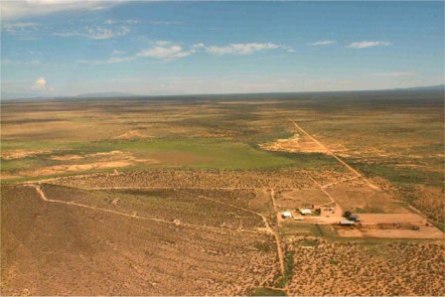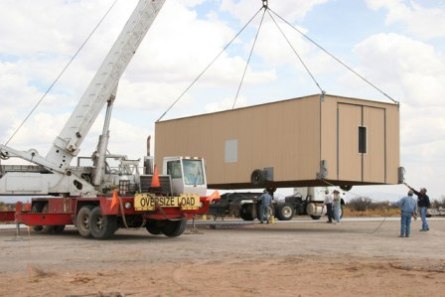To win that new industry New Mexico governor Bill Richardson has to succeed with, a Federal Aviation Administration spaceport licence application; a $100 million state bond issue; winning seven county plebiscites; convincing his legislature in January to give $25 million for transportation infrastructure construction; raising the remaining federal funds and not busting the $225 million spaceport price tag approved by his state’s legislature.
|
|---|
Above: In December 2005 Governor Bill Richardson and Sir Richard Branson announce Virgin Galactic's headquarters is to be at New Mexico's spaceport |
If successful the 6,990 hectare (17,200 acre) site for the spaceport, now renamed Spaceport America and located 72.4km (45 miles) north of the New Mexican city of Las Cruces, could see its anchor tenant and lessee Virgin Galactic and other space tourism providers launching tourists by the end of the decade.
It is a Futron corporation space tourism market study, paid for by the state, that is predicting a $759 million a year industry and 3,500 new jobs ten years after the expected start of spaceport operations. To achieve that annual turnover figure however, that study assumes that not only space tourism takes off but a whole new reusable launch vehicle and aircraft industry is created in the surrounding area.
In the meantime the state is paying for the spaceport’s $225 million cost with $100 million from the New Mexico government, through a state bond issue; $25 million from the New Mexico legislature for transportation infrastructure work; and $90 million from county sales tax increases and federal sources. A final $8.6 million for planning, design, engineering and land acquisition is already available from a fund set up for the aborted single stage to orbit Lockheed Venturestar commercial space project.
For the largest of those funding streams, the $100 million, three criteria must be met before the bond money is released: the state must secure an FAA spaceport licence, have an anchor tenant and receive construction cost bids of no more than $225 million. One of those criteria has already been met, Virgin Galactic is now the anchor tenant. It will sign a 20-year lease with payments for the first five years capped at $1 million per annum, beginning with the UK company’s occupancy at the spaceport expected in late 2009 or early 2010.
|
|---|
Above: Virgin Galactic's original plans for its spaceport headquarters |
The $8.6 million already available is paying for work by DMJM engineering, a US construction company that has worked on airports and theme parks.
|
|---|
Above: the prospective spaceport site |
The first test for Spaceport America will be the FAA’s office of commercial spaceflight decision to award the state’s Spaceport Authority’s application for a five-year spaceport licence. Part of that application requires data from a rocket launch. It was supposed to use data from the inaugural flight of the early spaceport customer and sounding rocket provider UP Aerospace’s XL booster but that failed when it crashed on 25 September. Instead of the XL rocket Spaceport America’s executive director Lonnie Sumpter expects that data from a Black Bryant sounding rocket, launched from the adjacent US Army White Sands Missile Range (WSMR), could be used instead.
|
|---|
Above: UP Aerospace's facility begins construction |
For the next test, which is the seven county plebiscites for local sales tax increases, opinion polls have current New Mexican voter support for the spaceport at 80%. Las Cruces city mayor William Mattiace is hoping a successful licence application will further help persuade the seven counties’ voters to vote yes. Those counties include Dona Ana, Socorro, Otera and Sierra, “we are selling it as a long term investment with a sunset clause on the taxes of 20 years. The [April 2007 plebiscite] is timed to avoid other votes, “ Mattiace says. He feels the spaceport is too important for voters’ feelings on other issues to influence their decision.
What exactly those tax rises will be is dependent on the outcome of a task force that is to report during this fourth quarter. For now New Mexico officials are suggesting an increase of up to one quarter of a cent to generate the monies, to be added to federal funds, to achieve the $90 million needed for construction. From Mattiace’s county, New Mexico’s most populous, Dona Ana, revenues from the increased sales tax could be as high as $7 million per year.
Because of the number of counties involved and the scale of the jobs and potential income the spaceport is being portrayed as a major event for the state. “It’s already [a] big event. Hopefully we can coordinate the [timing of the different counties’] votes,” says Mattiace, predicting a potential state-wide, multi-county one day electoral event.
To win votes Mattiace and his other mayoral counterparts are being very specific with voters about where the money is going and what the benefits are for individuals and counties. For example, 10-20% of the funds raised could go towards science education in schools. Despite the current high voter support and specific funding commitments spaceport officials are not assuming they can win every county.
“We feel five out of the seven will pass [the vote]. Socorro may be a tough sell,” says spaceport authority member William Loomis, while expecting an easier appropriation of federal funding, “our congressional delegates feel confident they can get the [federal departments’ support]. It would be fantastic to get them in 2008 [but] it is 2009 when we need them.”
New Mexico has a potential commercial competitor in the form of California’s Mojave Spaceport. It gained its five-year licence in 2004 for the suborbital flights of Mojave Aerospace Ventures' SpaceShipOne. Virgin Galactic, which will use Scaled Composites follow-on vehicle SpaceShipTwo, plans to operate from late 2008 from Mojave. Mojave spaceport is facing a license renewal in 2009 but is asking for its current licence to be altered for an increase in flight frequency and propellant types and an extension out to 2010 or 2011.
This year the spaceport failed to gain $11 million from the Californian legislator but its manager Stuart Witt does not feel defeated, “[the $11 million] stalled in the appropriations committee. We’re now expecting an infrastructure bank loan.”
While Mojave succeeded in becoming a spaceport two years ago New Mexico had hopes of becoming one years before that.
For the Venturestar the state was selected as its designated spaceport and the McDonnell-Douglas vertical take off, vertical landing rocket Delta Clipper was tested at WSMR. Building a new spaceport and potentially a new industry could represent challenges as difficult as sending some one into space so New Mexico’s cabinet secretary for economic development Rick Homans is realistic about what could go wrong.
“There are a number of unknowns that could derail the spaceport; if ranchers who own the land are not prepared to sell; or a problem arises with the land lease that the spaceport authority has with the New Mexico land office; or WSMR decides it is not happy with the situation; or the X Prize Cup events [that generate local interest] fail; or an unknown geological factor causes problems or the moving of a major power cable becomes [very problematic].”
Source: FlightGlobal.com























